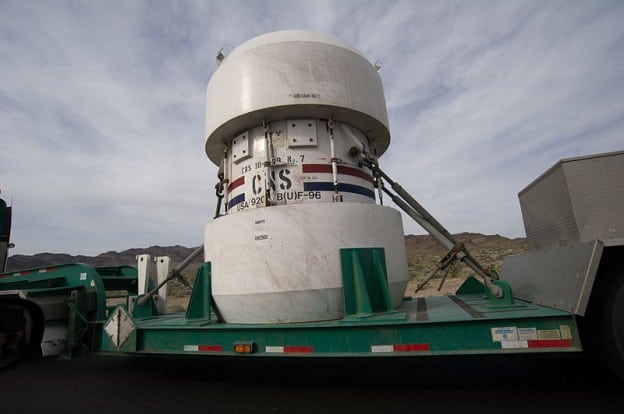The POWER Interview: Technology Can Solve Problem of Nuclear Waste
The post The POWER Interview: Technology Can Solve Problem of Nuclear Waste appeared first on POWER Magazine.

Debate continues about nuclear power's role in electricity production, particularly as it revolves around climate change. As a zero-emissions source of power, nuclear is seen by many as a complement to renewable energy in the transition away from coal-fired generation.
Nuclear power, though, has detractors, who point to nuclear accidents and say the risk is not worth the reward. Then there's the problem of what do with the spent fuel from nuclear power plants. (Read Age-Old Problem in Search of a Solution" in the September 2020 issue of POWER.)
The U.S. Department of Energy (DOE) has thrown its support, and millions of dollars, behind nuclear power, in an effort to revive the nation's nuclear industry. But while new reactor designs, including small modular reactors, are being developed, the problem of disposal of spent nuclear fuel remains a challenge.
Leslie Dewan, a renowned nuclear engineer and entrepreneur with multiple degrees from the Massachusetts Institute of Technology (MIT), spoke with POWER about the problem of nuclear waste and what she thinks about the pursuit of solutions. Dewan most recently founded Criticality Capital, a venture capital firm focusing on nuclear and other carbon-free energy investments. Dewan is well-known as the co-founder and CEO of Transatomic Power, a company founded in 2011 that worked to design and develop a molten salt reactor before its design data was placed into the public domain. She also was honored by TIME Magazine in December 2013, when TIME selected Dewan as one of 30 People Under 30 Changing the World."
 Leslie Dewan received degrees in mechanical engineering and nuclear engineering from the Massachusetts Institute of Technology (MIT), along with a Ph.D. in nuclear engineering from MIT. While at MIT, she was awarded a Department of Energy Computational Science Graduate Fellowship and an MIT Presidential Fellowship. Source: Instagram
Leslie Dewan received degrees in mechanical engineering and nuclear engineering from the Massachusetts Institute of Technology (MIT), along with a Ph.D. in nuclear engineering from MIT. While at MIT, she was awarded a Department of Energy Computational Science Graduate Fellowship and an MIT Presidential Fellowship. Source: InstagramPOWER: What do you think is the best solution for disposing of nuclear waste from the world's nuclear power plants? Is there a technology in use today, or not in use today, that would be the best (or a better) option?
Dewan: We'll need a combination of different technologies to address the nuclear waste problem properly. On the front end, we need to invest more in developing new types of reactors and new fuel forms, such as metallic uranium fuel, that can achieve a higher burnup than what's possible in commercial reactors today. Burnup is a measure of what fraction of the spent nuclear fuel underwent fission in a reactor. In a typical reactor today, burnup is about 5%. Increasing burnup decreases the overall radioactive lifetime of the waste, shifting its composition from longer-lived actinides to fission products, which generally have a far shorter half-life.
Ideally, then we could take this used nuclear fuel and extract additional energy by putting it back into a nuclear reactor. There are a number of different new reactor designs that will be able to do this, and countries like France and the UK already routinely re-use their spent fuel. Re-using spent nuclear fuel further shifts its composition from long-lived actinides to fission products. There's a caveat with this approach, however: reusing spent nuclear fuel typically requires reprocessing it-effectively, separating out key isotopes-and this can pose a proliferation risk.
But this doesn't solve the entire problem! Even with high-burnup reactors, reprocessing, and re-using the fuel, you still have waste left over. The current system involves first letting it cool down in a spent fuel pool, then in dry cask storage. This works well, but then you need to find a way to store it long-term. In my opinion, the best way to do this is with deep borehole repositories. These put the waste up to about 3 miles below the surface of the earth, thereby keeping it far away from groundwater and keeping it isolated on geological timescales.
POWER: Should there be a national waste repository, and if so, where should it be located or what type of geological formation (or other site) should be considered?
Dewan: Yes, this is an ideal area for the federal government to step in.
As for location, you want to site a repository in an area that's geologically stable, and where you can drill to depths far below any existing aquifers. Furthermore, you'd want to drill the repository into granite or saturated clay. These environments create what's called a reducing environment," which greatly minimizes corrosion and can help the waste canister to remain intact effectively indefinitely.
POWER: There are sites being built in Texas and New Mexico for interim storage of nuclear waste. Is this a good idea, and how can these sites overcome local opposition? Should the federal government intervene, or is this strictly a state matter?
Dewan: Interim storage is necessary, but it needs to be closely monitored. There's always a risk that the storage canisters could corrode or otherwise be damaged on longer timescales. Relatedly: I'd be really interested in seeing more companies developing better remote monitoring equipment for interim storage canisters and underground storage casks. There's a growing market for it, and better real-time monitoring would go a long way towards increasing public trust in these new storage facilities.
More broadly: this is an especially tricky problem because it's not going to be solved by new technology alone. We also need to make sure we're hearing the concerns of people living near the site, communicating with them about how the site works and how it might impact their community. The sites are safe, but they're not completely free of risk. And frankly, it will probably be very hard and will take a long time for the nuclear industry to have these conversations. The industry has, over the course of decades, lost a lot of the public's trust. We need to be especially open, communicative, and humble if we want to gain that trust back.
POWER: Do you have other thoughts about what could help solve the problem of storing nuclear waste?
Dewan: Interim storage will work for the next few decades, but we still need to think about the long term here. We can't just keep kicking the can down the road. The flip side of this is that we do have time to think deeply about the problem and get it right.
I'm very excited about the different research efforts and new companies that are tackling this problem, and I believe that a combination of higher-burnup reactors, waste-consuming reactors, deep borehole repositories, and new technology for remote monitoring will be able to solve this problem.
-Darrell Proctor is associate editor for POWER (@DarrellProctor1, @POWERmagazine).
The post The POWER Interview: Technology Can Solve Problem of Nuclear Waste appeared first on POWER Magazine.